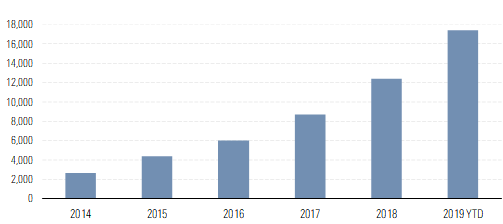The Road Ahead Looks Promising for Intel's Mobileye
The leader in advanced driver-assistance systems contributes only a small part of the chipmaker's overall revenue for now, but sales are growing.
Because of Mobileye's relatively small contribution to Intel's INTC total sales (only 1% of 2018 revenue), we understand why many investors might overlook the subsidiary and even question why Intel owns this business at all when it faces stiff competition in its core PC and data center segments. But since Intel acquired Mobileye in 2017 for $15.3 billion, the leader in advanced driver-assistance systems, or ADAS, has been steadily increasing its annual design wins while growing revenue at a healthy double-digit rate. The firm is on track to surpass $1 billion in sales in 2020, and we believe it will approach $3 billion by 2023, which supports our assumptions of mid-single-digit revenue growth for Intel as a whole.
Founded in 1999, Israeli-based Mobileye supports automotive vision systems that use cameras, processors, and pertinent software algorithms. While the camera can come from a variety of suppliers, Mobileye's contributions revolve around the processor that makes the camera "smart" (EyeQ vision processor) and overarching software algorithms that identify objects such as pedestrians and other vehicles. In contrast to competing solutions that use visual detection, radar, and lidar sensors, Mobileye primarily focuses on the visual aspect of sensing for its ADAS features (a single camera mounted in the rear-view mirror). Mobileye does not eschew radar or lidar sensors—rather, it plans to use a camera-centric approach to build full autonomous vehicle capability, then add radar and lidar as a secondary layer for true redundancy. Given its existing portfolio of computer vision products found in vehicles today, we expect Mobileye (and thus Intel) to be a meaningful player in future AVs.
At its first investor day since being acquired, CEO Amnon Shashua outlined how the firm is financing its AV endeavors with its highly profitable ADAS business, noting that unlike peers, Mobileye is generating enough income to continue investing in AV. We think this is a defining aspect for Intel compared with similar efforts by Nvidia and Google's Waymo, which we believe are far from generating material revenue.

Mobileye Has Demonstrated Impressive EyeQ Shipment (Thousands) Growth - source: Mobileye
As of November 2019, Mobileye has shipped over 50 million EyeQ chips, a 46% compound annual growth rate, since 2014. It also boasts an impressive pipeline, with 45 production programs across 26 original equipment manufacturers and 22 design wins this year. Once Mobileye wins a design contract, it must submit to a two- to three-year collaboration with the carmaker and Tier 1 supplier before its technology is launched in production vehicles. These programs are highly sticky and give us confidence in Mobileye's ability to continue generating strong double-digit EyeQ shipment growth.
Before its acquisition, Mobileye was already a prominent ADAS company, creating software for developmental AVs and its Road Experience Management crowd-sourced mapping data program. After the acquisition, it has expanded its product scope across mobility-as-a-service, self-driving systems as an off-the-shelf product, an open computing platform for OEMs such as BMW BMW to program themselves, and a division working on sensors that include lidar and cutting-edge radar using Intel technology such as silicon photonics. Each of these segments is interlinked through the goal of developing full AV, and the combination of Mobileye being self-funded but also having the might of Intel's technology and resources behind it is a compelling value proposition, in our view. In turn, Shashua contends that Mobileye will be able to move into higher-value arenas such as AV maps, robo-taxis, consumer AV, and AV sensors.
We gave Mobileye a narrow moat rating as a stand-alone company, and under the Intel umbrella, we see no signs of its competitive advantage eroding.
A Best Idea Wide-moat Intel is one of our Best Ideas in the technology sector, thanks in part to its opportunities with Mobileye. We expect Intel's Mobileye to maintain its gaudy double-digit growth rate (31% CAGR from 2018 to 2023). Although the near term will remain challenging for Intel because of modest share loss in its core PC and data center segments to Advanced Micro Devices AMD, we expect it to defend its dominant position in the server market (retaining 80%-plus share) in the long run thanks to aggressive pricing and upcoming 10-nanometer Ice Lake server CPUs in 2020. Overall, we consider Intel undervalued, as the market doesn't yet seem to appreciate the favorable prospects for Mobileye.

/s3.amazonaws.com/arc-authors/morningstar/426795a6-50a8-4320-8dea-8c93d2bfd246.jpg)
/cloudfront-us-east-1.images.arcpublishing.com/morningstar/WC6XJYN7KNGWJIOWVJWDVLDZPY.png)
/cloudfront-us-east-1.images.arcpublishing.com/morningstar/HHSXAQ5U2RBI5FNOQTRU44ENHM.jpg)
/cloudfront-us-east-1.images.arcpublishing.com/morningstar/737HCNGRFLOAN3I7RKGB7VPEKQ.png)
:quality(80)/s3.amazonaws.com/arc-authors/morningstar/426795a6-50a8-4320-8dea-8c93d2bfd246.jpg)